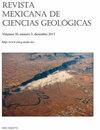墨西哥萨卡特卡斯早-晚期亨菲利亚人农业兽(哺乳-熊科)完整肱骨的首次记录
IF 0.5
4区 地球科学
Q4 GEOSCIENCES, MULTIDISCIPLINARY
Revista Mexicana De Ciencias Geologicas
Pub Date : 2023-07-30
DOI:10.22201/cgeo.20072902e.2023.2.1738
引用次数: 0
摘要
描述了一个完整的肱骨,称为Agriotherium,从萨卡特卡斯的早-晚亨菲尔期沉积物中收集。Agriotherium在欧亚大陆和北美洲的早-晚亨氏动物群中广泛分布于孤立的臼齿、下颌骨和上颌骨。在文献中,颅后元素很少,并且很少详细地进行简要描述。南非Langebaanweg采石场的多样性最大;然而,唯一完整的标本来自墨西哥。对近端进行了描述,肱骨与南非对远端的描述相似,其中内侧上髁和外侧上髁的嵴减少,这可以被认为是狩猎更大猎物觅食的限制。这意味着Agriotherium不是严格意义上的肉食性动物,而是一种以植物和水果为杂食的食肉食腐动物。本文章由计算机程序翻译,如有差异,请以英文原文为准。
First record of a complete humerus of Agriotherium (mammalia-ursidae) from the early-late Hemphillian of Zacatecas, Mexico
A complete humerus referred to Agriotherium is described, collected from early-late Hemphillian deposits from Zacatecas. Agriotherium is widely represented by isolated molars, mandibles, and maxillae in early-late Hemphillian faunas of Eurasia and North America. In the literature, postcranial elements are scarce and briefly described with little detail. The greatest diversity is known from the Langebaanweg quarry in South Africa; however, the only complete specimen is from Mexico. The proximal end is described, and the humerus shares similarities with the description of the distal end from South Africa, in which the medial epicondyle and crest of the lateral epicondyle are reduced, which can be considered as a limitation in the hunting of larger prey for food. This implies that Agriotherium was not strictly carnivorous but was a predator-scavenger with an omnivorous diet that included plants and fruits.
求助全文
通过发布文献求助,成功后即可免费获取论文全文。
去求助
来源期刊

Revista Mexicana De Ciencias Geologicas
地学-地球科学综合
CiteScore
1.00
自引率
12.50%
发文量
0
审稿时长
6-12 weeks
期刊介绍:
Revista Mexicana de Ciencias Geológicas (RMCG) publishes original research papers on geological processes of broad interest, and particularly those dealing with regions of Latin America. The RMCG also publishes review papers on topics of current interest, and on the geology and tectonics of geological provinces of Latin America. Besides, it offers the opportunity for host editors to publish special thematic issues.
 求助内容:
求助内容: 应助结果提醒方式:
应助结果提醒方式:


